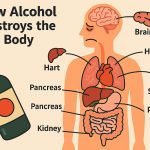When a person stops eating, the body doesn’t immediately shut down — instead, it begins a carefully coordinated shift in energy sourcing. In the first 6–12 hours, the body relies on glucose from recent meals. This sugar circulates in the blood and fuels most cells, especially the brain, muscles, and red blood cells.
As blood glucose drops, the liver begins breaking down glycogen — a stored form of glucose — to maintain energy levels. Most glycogen reserves are depleted by 12–24 hours.
12–24 Hours: Transition to Fat Burning
After the body exhausts its glycogen stores, it begins a process called gluconeogenesis — creating glucose from non-carbohydrate sources like amino acids. Simultaneously, it increases the breakdown of fatty acids from fat tissue.
At this stage:
- Blood insulin levels drop
- Glucagon and adrenaline rise, promoting fat breakdown
- Ketone production begins — especially in the liver — as a backup fuel source for the brain
People may experience:
- Mild fatigue or dizziness
- Irritability (sometimes called “hangry”)
- Heightened sense of smell or alertness
24–48 Hours: Ketosis and Protein Preservation
By the second day, the body shifts into early ketosis, where ketones become the primary fuel for the brain instead of glucose. This adaptation reduces the breakdown of muscle protein, preserving lean tissue for as long as possible.
During this phase:
- Appetite may decrease, due to elevated ketones
- Energy levels can stabilize or fluctuate depending on the individual
- The body begins using fat stores more efficiently for fuel
However, some may experience:
- Headaches
- Mental fog or sluggishness
- Bad breath due to acetone (a ketone body) in the breath
Is It Dangerous?
In healthy adults, a 48-hour fast is not typically dangerous, though it should be avoided by:
- Children
- Pregnant or breastfeeding women
- People with diabetes or metabolic disorders
- Anyone with a history of eating disorders
Hydration is crucial. The body loses water and electrolytes during fasting, so drinking water — possibly with added sodium or potassium — is important to avoid dizziness or fainting.
What’s Not Happening Yet
Many myths suggest that fasting causes immediate “starvation mode” or extreme muscle loss. In reality:
- The body protects muscle early on
- Metabolism doesn’t crash in the first 48 hours
- Hunger hormones like ghrelin may temporarily increase but often stabilize
Glossary
- Glycogen – A stored form of glucose found in the liver and muscles.
- Ketones – Molecules made by the liver from fat to provide energy during low-carb or fasting states.
- Gluconeogenesis – The process of creating glucose from non-carbohydrate sources.
- Ketosis – A metabolic state where fat becomes the primary energy source.
- Ghrelin – A hormone that increases appetite.


